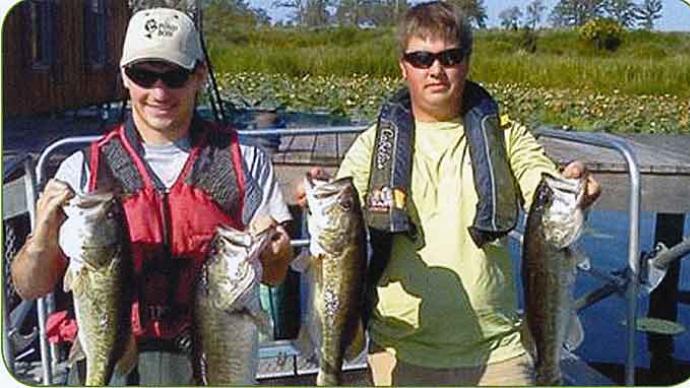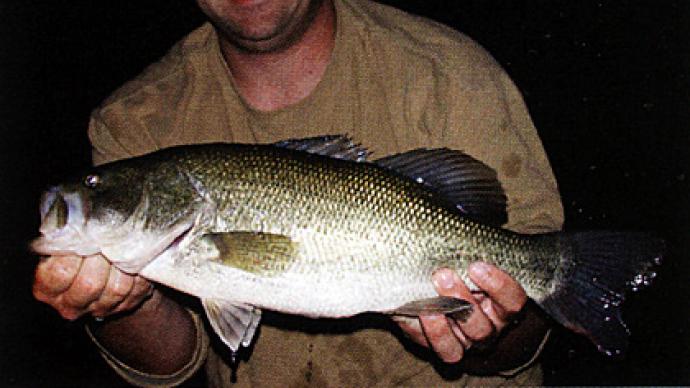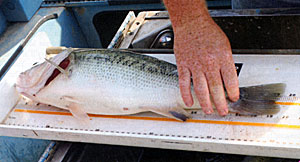
My dad liked to tease us kids and I remember one particular day when he got me good. I was fourteen years old, and I'd enjoyed being home alone for a few hours. At the supper table that night, dad looked at me with that look and asked, "Anyone come here today, while you were here by yourself?" I looked up over my fork, and said, "No sir." He said, "Are you positive?" "Absolutely positive," I said. There had been no one at our house, period. "Wanna bet your allowance on it?"
I thought for an instant. Wow, instead of five bucks, I was about to be the recipient of a crisp ten-dollar bill. There's no way anyone had been here during my watch and he couldn't prove otherwise.
I nodded.
Dad said, "Yes, there was."
My heart rate went up. In my adolescent mind, I knew I was right. "Prove it," I challenged.
Dad smiled, "Go open the front door."
Dangling by its string from the metal loop on the bottom of the mailbox was a package wrapped in brown paper with my name on it. I carried it to the table, and dad said, "Open it," so I ripped open the paper and discovered two sports books I'd been wanting—an early birthday present.

I thanked dad for the books and my younger brother, the smart boy of the family, said, "Yeah, those books just cost you five bucks."
Dad chuckled and said, "There are lots of invisible people and things in the world that you never see. The mailman delivered those books. Just because you didn't notice him or didn't see him, doesn't mean he wasn't here...remember the invisible people."
That lesson stuck. I was thinking about it the other day, and realized it relates to something invisible I take for granted in my job as a professional fisheries biologist, namely electricity, and your fish under that water.
I use electricity often because it allows me to see an otherwise invisible fish population. I probably electrofish 40-60 lakes per year to study the fishery and check the status of the wet creatures beneath the water's surface. It simply doesn't cross my mind that you, dear readers, might not have ever seen or even heard of electrofishing. Therefore, let me paint the picture for you.
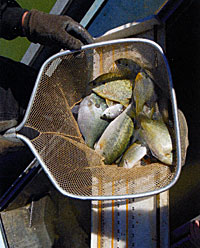
Electrofishing, in its most basic sense, is the use of a special boat, designed to create an underwater arc of electricity, generated on board by a gas powered generator, to gently stun fish in a random fashion so they can be collected, counted, identified, weighed, measured, and released unharmed back into their environment. Electrofishing is used for population analysis and to give an underwater snapshot of the fishery on that day.
Without getting too technical, there are different wavelengths of electricity, offering the operator the ability to adjust the current based on a variety of situations. Believe it or not, pure water doesn't conduct electricity. What's dissolved into water does. Metals and minerals dissolve in varying degrees in water, thus the need to adjust the electricity. That, and the fact that different species or sizes of fish react differently to different wavelengths of electricity.
Electrofishing is by far my favorite sampling method to check a fishery. However, it has limits. For most boats, we can only shock fish downward to six feet deep. So, we're limited to seeing fish that reside in that part of the lake. Therefore, electrofishing is typically most effective along shoreline areas. But, I will move through the deeper water, especially if I'm looking for shad or other types of fish which reside in the upper water column.
If the mission is to gather a complete set of data for a given lake, other sampling methods are used. Those may be seines, hoop nets, fyke nets, gill nets, or traps, but those are sampling stories for another day.
All electrofishing boats are equipped with safety features. If not, stay away—far, far away. Safety is a big issue with electrofishing. My boat has double-safety features. We have foot switches on the bow that must be depressed, plus there's an emergency switch on the console, in front of the pilot.
When the boat is launched, we typically have a strategy and a specific reason to electrofish. Most of the time, our electrofishing endeavors are to monitor the progress of a managed fishery. But, we've also electrofished to collect fish in order to examine stomach contents to figure out how the fish seasonally capitalize on their food chain in a given lake. Another reason is a tag and recapture effort. When fish are tagged, you can track them via electrofishing and get an educated guess as to how many mature fish might be living in that lake and how individual fish are growing. Another reason, fairly common, is to harvest excess predator fish from a lake, especially bass.
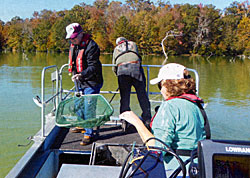
After launching, the generator is cranked up, the livewell pump is turned on, and we start moving slowly along the periphery of the lake. As fish turn on their sides, temporarily stunned, they are collected with long fiberglass-handled dip nets and gently placed into the big live well with fresh lake water circulating through it. Different biologists go through this process differently. Some electrofish for a given period of time and then stop to weigh, measure, and release the catch. Others go until the live well is full enough and then process the fish for data.
There are several really important concepts to understand about electrofishing, especially if you have the desire to have your own boat, home-made or from a professional shop. Yes, you can build an electrofishing unit. There are plans out there. How many times have you heard the stories from a family member or friend about their uncle or his buddy who had an old "crank phone" unit to shock fish? Or, most lately, game wardens tell the tale of finding homemade units smaller than an ice cube that does the duty. Of course, most of these stories occur in public water—and are illegal. Plus, that many amps kill fish. The handful of people I've counseled over the years who wanted an electrofishing boat had to really sell me on the idea, or I'd have no part of it. That's a total of three people in 34 years. Those folks had a distinct need for an electrofishing boat.
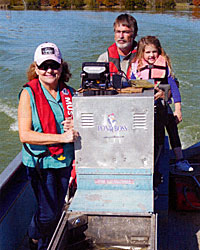
Here's why.
While the concept seems simple: generate electricity, put it in the water to stun fish, and then catch the fish. But there is much, much more to it. Assuming the safety issues are overcome, you have to understand what it is you are seeing.
Simply capturing fish, weighing, measuring, harvesting, and releasing is not as easy as it sounds. It takes most biologists years to gain a full understanding of what they are seeing as those fish come into the boat. It's not as simple as collecting 50 bass, weighing them, measuring them, and releasing the fish back into the lake, plotting the data on a spreadsheet and reading a few graphs and then comparing that data to whatever food items were captured as well. Understanding the data is important. But, as the boat moves through the water, there are a lot more data points being processed through the biologist's brain.
For example, I notice where the fish are distributed. With a pretty good knowledge of fish behavior, I can often see a clue as to the status of the fishery that could be clouded if we only looked at numbers.
Here's a case in point. I electrofished a club lake in Arkansas a few years ago. There had been a fish kill, but the owners didn't know the extent. They could go fishing and catch a few bass, but not many. They wanted to know the status of their fishery early the next year, so they could take corrective action as needed. We launched the boat and went to work. We spent about three hours capturing fish on that 30-acre lake. We gathered about 30 bass, rotund creatures that pushed well beyond three pounds each. But, the most telltale sign I saw was distribution, size range, and numbers of bluegill. On every bush we topped, hundreds of 3-4 inch bluegill would boil out. We went over one submerged tree near the dam, where bass should be hanging out, and I bet there were 500 bluegills lingering there. That's not normal. In a well-balanced bass lake, we shouldn't be seeing bluegills dominating bass habitat. Nor, would they be hanging out where bass normally stay. They'd be elsewhere, in more dense cover in shallow water, trying not to be eaten. The club's answer was a pretty easy one—re-stock the lake with advanced bass—fish that can eat the dominant size classes of bluegills to fill that missing gap. I also recommended paying attention to the large amounts of coontail, which likely contributed to the fish kill via oxygen depletion due to too many plants consuming oxygen during hot, sultry, cloudy summer days.

Another example was an Oklahoma lake built by a landowner, literally. This young lake, a rising star, was raising some nice fish. Covering almost 30 acres, the lake's landowner was concerned because his catch rates were too low to suit him. We launched the boat and it didn't take long to see what was going on. There was a complete year class of bass missing from the young population. We caught some 3-5 pound bass (three years old) and lots of bass in the 6-8" size class, hatched that year. But, where were last year's fish? This electrofishing survey occurred during the fall months. There should have been some 14-16" year and a half old bass, but we didn't see but a handful of those. We stopped the boat after thirty minutes.
The owner's puzzled look and follow up question said it all. "What's going on? Shouldn't we be seeing more fish?"
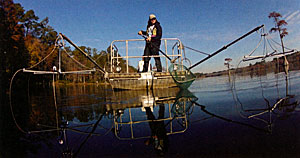
The first question I had was, "Did you have water turkeys (cormorants) last winter?"
His answer was a quick, "Yes, we did." That was the problem. Birds had overharvested a key size class of bass and this lake was on its way to a problem. That lake was on its way to overcrowded small bass, with a few giants, and too many intermediate sized bluegills that the smaller bass couldn't eat—their mouths weren't big enough. Sure, he might be on his way to growing a handful of bass to the new Oklahoma state record, but that wasn't what he wanted. Luckily, his brother had another lake in a hidden valley a few miles away that was renowned for overcrowded bass, so we headed over there, harvested about 200 bass, just the right size, with the electrofishing boat, moved them to the victimized lake, and helped both bodies of water.
As you can see, electrofishing has a multitude of purposes, primarily to figure out the current status of a fishery. It's lots of fun, but understand that what you see underneath the water are simply clues as to what you need to do next.
By the way, my mom saw to it that I got that week's allowance. She always seemed to take care of things like that. It was certainly no shock. And, I never took her for granted.
Reprinted with permission from Pond Boss Magazine

